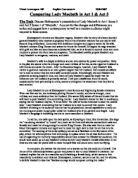Darkness appears as a metaphor for evil. For instance, in the quote “And oftentimes, to win us to our harm/ The instrument of darkness tell us truths”, Banquo tries to prevent Macbeth form the devilish intentions of the witches. “Instruments of darkness” is a metaphor used in comparison with the witches. Banquo reveals the true nature of the strange sisters and their prophecies. In addition, since Macbeth does not listen to him, and seems hypnotized by the witches, we can question ourselves at this moment in the play: is Macbeth an instrument of darkness himself?
Shakespeare uses light as a metaphor for nobleness and order, which are often related to the king Duncan. In one of king’s words; “Which honor must not unaccompanied invest him only/ but signs of nobleness, like stars, shall shine /on all deservers", Duncan thanks the two generals and uses the stars as a symbol of nobleness. King Ducan guarantees his throne to his son, as the tradition wants. The light of the starts shines on the new king. Therefore, this brightness can suggest that the order in the world is respected. In most culture, the king is associated with the sun. Consequently, “And you whose places are the nearest”to the sun, reinforces the idea that lights signifies the natural order.
Directly in response to Duncan, and to the announcement that Malcolm will become the successor to the throne of Scotland, Macbeth asks the stars not to bright and immediately darkness takes place in his words; "... Stars, hide your fires, let not light see my black and deep desires”. His profound desires are evil, dark. His intentions of murdering both King Duncan and the Prince of Cumberland are apparent, but he can’t stand to have the light of the starts shine on him, and reveal the truth. Macbeth tries to hide from the light, the devilish ideas of his soul. In contrast with the King words, there is no more sign of nobleness in his speech, but only signs of evil.
Furthermore, the darkness is as well used to hide Lady Macbeth’s plans. Indeed, “"Come, thick night, and pall thee in the dunnest smoke of hell, that my keen knife see not the wound it makes, nor heaven peep through the blanket of the dark" demonstrates the fear of Lady Macbeth to discover her real intentions. She wants to cover her thoughts with a pall and let no anyone see it. And she does not want to see it herself. Shakespeare uses darkness to wrap the bad intentions of his characters, especially Macbeth and his wife. The dark mood of the last two quotes is employed to demonstrate to the audience the step of the Macbeth and Lady Macbeth toward evil. Moreover, many of the scenes in the play are set at night (i.e. the dinner with Duncan, the apparition of the witches…) .
The first act of Macbeth is important as it brings one of the major theme of the play; the constant struggling of good and evil. In the light of this study, we can see that Shakespeare uses contrast between light and darkness to emphasis this image of opposition between good and bad and sets the atmosphere of the play.
Word count: 718







